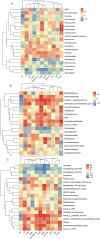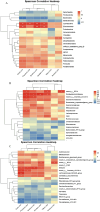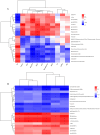Effect of supplementation with L-Citrulline on rumen microbiota structure, plasma metabolites, reproductive hormones, and antioxidant capacity of Hu ewes
- PMID: 40641874
- PMCID: PMC12243934
- DOI: 10.3389/fmicb.2025.1606437
Effect of supplementation with L-Citrulline on rumen microbiota structure, plasma metabolites, reproductive hormones, and antioxidant capacity of Hu ewes
Abstract
L-Citrulline (L-Cit), a non-essential amino acid, is characterized by its unique extrahepatic metabolism, which significantly enhances the bioavailability of arginine metabolism in tissues. This study investigated the impact of L-Cit supplementation on ruminal microbiota composition, plasma metabolites, reproductive hormones, and antioxidant capacity in Hu ewes. Sixty non-pregnant Hu ewes, similar in age and parity, with an average body weight of 47 ± 5.05 kg, were randomly assigned to either a Control group or Experimental group. The Control group received a basal diet, while the Experimental group was supplemented with 10 g/d of L-Cit in addition to the basal diet for 65 days. Compared to the Control group, the Experimental group exhibited a significantly higher estrus rate. Plasma estradiol (E2) levels were significantly reduced (p < 0.01), while luteinizing hormone (LH) and follicle-stimulating hormone (FSH) concentrations showed significant increases (p < 0.05). Testosterone (T) content was also significantly elevated (p < 0.01). Plasma levels of superoxide dismutase (SOD), malondialdehyde (MDA), glutathione peroxidase (GSH-PX), catalase (CAT), and total antioxidant capacity (T-AOC) were significantly higher in the experimental group, with highly significant differences (p < 0.01). The 16S rRNA sequencing analysis revealed that at the phylum level, the relative abundance of Bacteroidetes was decreased, while that of Firmicutes was increased in the experimental group. At the family level, the relative abundance of norank_o__Clostridia_UCG-014 was significantly increased. At the genus level, the relative abundance of Prevotellaceae_UCG-003 was significantly decreased. The main enriched pathways in the CON group were identified as Lipoic acid metabolism and Nicotinate and nicotinamide metabolism. The main enriched pathways in the experimental group were identified as Prion diseases, Chlorocyclohexane and chlorobenzene degradation, Chloroalkane and chloroalkene degradation, Biofilm formation-Escherichia coli, and Phosphotransferase system (PTS). LC-MS analysis indicated significant upregulation of pathways such as drug metabolism by other enzymes, folate biosynthesis, and valine, leucine, and isoleucine biosynthesis, whereas oxidative phosphorylation and propanoate metabolism were significantly downregulated. These results demonstrate that L-Cit supplementation in the diet modulates the ruminal microbiota of Hu ewes, optimizing volatile fatty acid (VFA) proportions, enhancing carbohydrate metabolism, improving xenobiotic degradation capacity, stimulating the synthesis and release of reproductive hormones. Ultimately, these coordinated effects led to a synergistic increase in estrus and conception rates.
Keywords: L-Citrulline; antioxidant capacity; reproductive hormones; rumen microbiota; untargeted metabolomics; volatile fatty acids.
Copyright © 2025 Liu, Li, Fan, Wang, Liu, Zhao and Yang.
Conflict of interest statement
ZL was employed by the Xinjiang Shangpin Meiyang Technology Co., Ltd. The remaining authors declare that the research was conducted in the absence of any commercial or financial relationships that could be construed as a potential conflict of interest.
Figures













Similar articles
-
Changes of fecal microbiota with supplementation of Acremonium terricola culture and yeast culture in ewes during lactation.J Anim Sci. 2025 Jan 4;103:skaf174. doi: 10.1093/jas/skaf174. J Anim Sci. 2025. PMID: 40380819
-
Evaluation of garlic skin as a forage source for goats: Effects on performance, antioxidant capacity , immune function and.Anim Biosci. 2025 Jul 11. doi: 10.5713/ab.25.0169. Online ahead of print. Anim Biosci. 2025. PMID: 40665731
-
Ruminal Yeast Strain with Probiotic Potential: Isolation and Characterization and Its Effect on Rumen Fermentation In Vitro.Microorganisms. 2025 May 30;13(6):1270. doi: 10.3390/microorganisms13061270. Microorganisms. 2025. PMID: 40572158 Free PMC article.
-
Folate supplementation in people with sickle cell disease.Cochrane Database Syst Rev. 2018 Mar 16;3(3):CD011130. doi: 10.1002/14651858.CD011130.pub3. Cochrane Database Syst Rev. 2018. PMID: 29546732 Free PMC article.
-
Folate supplementation in people with sickle cell disease.Cochrane Database Syst Rev. 2016 Feb 16;2:CD011130. doi: 10.1002/14651858.CD011130.pub2. Cochrane Database Syst Rev. 2016. Update in: Cochrane Database Syst Rev. 2018 Mar 16;3:CD011130. doi: 10.1002/14651858.CD011130.pub3. PMID: 26880182 Free PMC article. Updated.
Cited by
-
Untargeted Metabolomic Identifies Potential Seasonal Biomarkers of Semen Quality in Duroc Boars.Biology (Basel). 2025 Aug 4;14(8):995. doi: 10.3390/biology14080995. Biology (Basel). 2025. PMID: 40906140 Free PMC article.
-
Clostridioides difficile meets the adenosine system: the art of manipulating host homeostasis.J Biomed Sci. 2025 Jul 11;32(1):66. doi: 10.1186/s12929-025-01160-8. J Biomed Sci. 2025. PMID: 40646589 Free PMC article. Review.
References
-
- An M. (2022). Effects of dietary L-citrulline supplementation on reproductive performance, lactation performance, and lamb growth in Hu ewes, thesis, Xinjiang Agricultural University, Urumqi
-
- Calabrò S. (2015). “Plant secondary metabolites” in Rumen microbiology: From evolution to revolution. eds. Puniya A., Singh R., Kamra D. (New Delhi: Springer; ), 153–159.
-
- Cynober L., Le Boucher J., Vasson M. P. (1995). Arginine metabolism in mammals. J. Nutr. Biochem. 6, 402–413. doi: 10.1016/0955-2863(95)00066-9 - DOI
LinkOut - more resources
Full Text Sources
Miscellaneous

